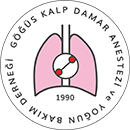

Metabolik Sendromlu Koroner Baypas Hastalarında Uygulanan İki Farklı Anestezi Tipinin Postoperatif Karaciğer Fonksiyonları Üzerine Etkisi
Hülya Yiğit Özay1, Aslı Demir1, Melike Kaya Bahçecitapar21Ankara Şehir Hastanesi Anesteziyoloji Ve Reanimasyon Kliniği, Ankara2Hacettepe Üniversitesi İstatistik Anabilimdalı, Ankara
Amaç: Metabolik sendromlu (MS) hastaların koroner baypas cerrahisinde (KABG) karaciğer fonksiyonlarını etkileyen faktörlerden biri kullanılan anestezi ilaçları olabilir. Bu amaçla KABG geçirecek MSlu hastalarda, midazolam bazlı total intravenöz anestezi(TİVA) ve sevofluran bazlı inhalasyon anestezi uygulamasının, karaciğer fonksiyonları ve postoperatif komplikasyonlar üzerine etkilerini araştırdık.
Yöntem: Çalışmamıza 76 hasta dâhil edildi. TİVA (n=38) ve SEVO (n=38) grupları arasında cinsiyet, yaş, vücut kitle indeksi (VKİ), euroscore değerleri, ameliyat öncesi komorbidite varlığı, kan ürünü transfüzyonu, postoperatif komplikasyon ve 30 günlük mortalite oranları açısından istatistiksel olarak anlamlı bir fark yoktu (p>0.05). Preoperatif ve postoperatif laboratuvar parametrelerine göre karşılaştırıldığında her 2 grupta da ALT, AST, LDH ve glukoz değerleri benzer bulundu.
Bulgular: Çalışmamızda, metabolik sendromlu koroner baypas hastalarında midazolam bazlı TİVA ve sevofluran bazlı inhalasyon anestezi uygulamalarının birbirine üstünlüğü olmadığını saptadık. Daha fazla sayıda hasta ile detaylı parametrelerin araştırıldığı çalışmalar bu konu için yol gösterici olacaktır.
Sonuç: Çalışmamızda, metabolik sendromlu koroner baypas hastalarında midazolam bazlı TİVA ve sevofluran bazlı inhalasyon anestezi uygulamalarının birbirine üstünlüğü olmadığını saptadık. Daha fazla sayıda hasta ile detaylı parametrelerin araştırıldığı çalışmalar bu konu için yol gösterici olacaktır.
Anahtar Kelimeler: Metabolik sendrom, koroner baypas cerrahisi, sevofluran, midazolam, obezite
The Effect of Two Different Types of Anesthesia on Postoperative Liver Functions in Patients with Coronary Bypass with Metabolic Syndrome
Hülya Yiğit Özay1, Aslı Demir1, Melike Kaya Bahçecitapar21Ankara City Hospital, Department Of Anesthesiology And Reanimation, Ankara2Hacettepe University, Department Of Statistics, Ankara
Objective: One of the factors affecting liver functions in open coronary surgery (CABG) of patients with metabolic syndrome (MS) may be the anesthetic drugs used. For this purpose, we investigated the effects of midazolam-based total intravenous anesthesia (TIVA) and sevoflurane-based inhalation anesthesia on liver functions and postoperative complications in patients with MS who wiould undergo open coronary bypass surgery.
Method: A total f 76 patients were included in our study. A statistically significant difference was not found between the TIVA (n=38) and SEVO (n=38) groups in terms of gender, age, body mass index (BMI), Euroscore values, presence of preoperative comorbidity, blood product transfusion, postoperative complications, and 30-day mortality rates. (p>0.05). Preoperative and postoperative laboratory parameters, ALT, AST, LDH, and glucose values were comparable between both groups.
Results: 76 patients were included in our study. There was a statistically significant difference between the TIVA (n=38) and SEVO (n=38) groups in terms of gender, age, body mass index (BMI), euroscore values, presence of preoperative comorbidity, blood product transfusion, postoperative complications, and 30-day mortality rates. There was no difference (p>0.05). When compared according to preoperative and postoperative laboratory parameters, ALT, AST, LDH, and glucose values were found similar in both groups.
Conclusion: In our study, we found that TIVA and SEVO groups are not superior to each other in coronary bypass patients with metabolic syndrome. Studies investigating detailed parameters with more patients will be guiding for this issue.
Keywords: Metabolic syndrome, coronary bypass surgery, sevoflurane, midazolam, obesity
Makale Dili: Türkçe
(1007 kere indirildi)

















